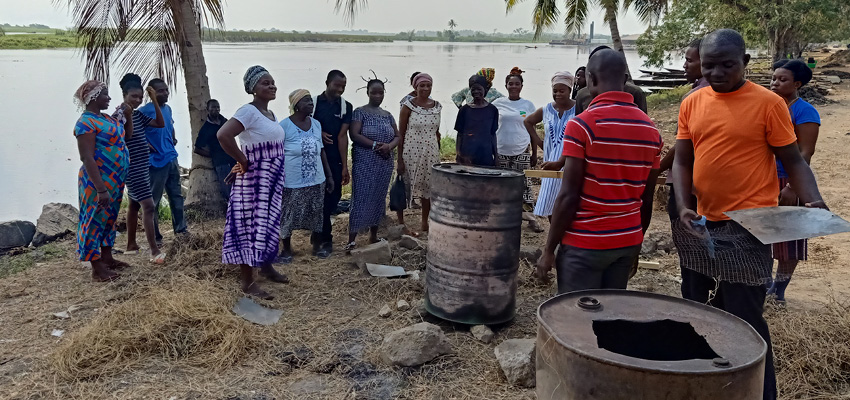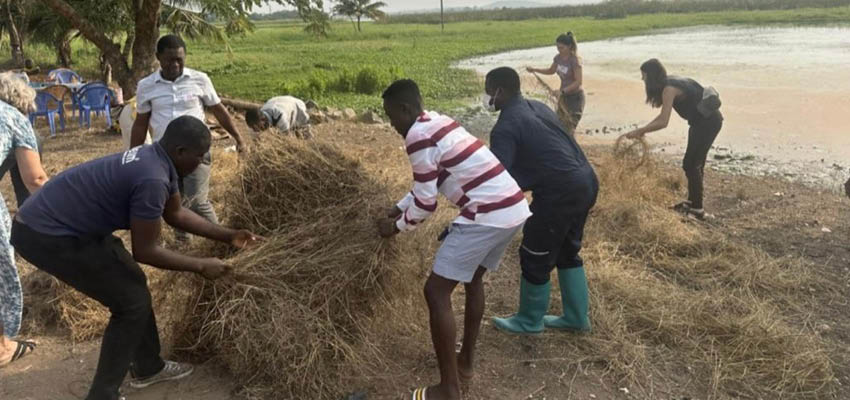
The challenge
Water hyacinth is an invasive plant species that clogs waterways and adversely affects riparian habitats around the world. It has significant negative economic, environmental, and health impacts, as its growth impedes fishing, irrigation, and transportation. Furthermore, since its presence slows down the flow of rivers, it also leads to increases in malaria and other water-borne diseases that are transmitted by vectors that live in slow-moving or stagnant water.
Water hyacinth is pervasive in the Volta River basin in eastern Ghana and has had additional detrimental effects due to the disruption of energy production at the hydroelectric power plants. The weeds clog the turbines and in addition, evapotranspiration processes lead to significant losses in the quantity of water that flows through the turbines. Although a variety of initiatives have been put in place to manage the impacts of water hyacinth, they have largely been unsuccessful at curbing the growth and mitigating the negative consequences of the hyacinth infestation.
The opportunity
Water hyacinth is a remarkably fast-growing plant, which is the major challenge, but also presents an opportunity. This project seeks to develop a process to make charcoal from water hyacinth, which simultaneously addresses two major environmental issues: deterioration of waterways due to the growth of water hyacinth and deforestation caused by using wood and wood charcoal as cooking fuel. The Ghana Energy Commission reports that more than 75% of Ghanaians rely on wood or wood charcoal as their primary cooking fuel, while the Forest Commission estimates that more than 90% of all trees cut in Ghana are used for cooking. This project therefore has multiple benefits:
- it promotes the removal and use of water hyacinth, which benefits the local riparian environment
- it replaces charcoal made from wood, which helps to prevent deforestation
- it produces a valuable product that provides economic opportunities for communities living in the Volta River basin
If successful, this project could be replicated in other areas in Ghana and be scaled up around the world.
We envision this project proceeding in four phases over four years as described below.
Stakeholder engagement & project planning
In this phase, a team from D-Lab will travel to Ghana to meet with the main collaborators from the Technology Consultancy Centre of the School of Engineering at the Kwame Nkrumah University of Science and Technology as well as staff from the Geography and Rural Development department, who have relevant experience in assessing the use of water hyacinth. Following the initial meetings on the KNUST campus, the team would travel to Akosombo to conduct a site visit to the Volta River basin to identify and meet with additional stakeholders. The team would also visit riverside communities to identify up to three communities to engage in the project. At the end of the site visit, key stakeholders will assemble for a planning and visioning meeting for the next phases of the project.
Co-creating solutions
The second phase of the project will focus on the development of technical solutions to address issues of harvesting and drying water hyacinth and its subsequent conversion to charcoal. D-Lab and KNUST will co-host a co-creation summit and will reach out to our global network of sustainable charcoal producers as well as engage local artisans, students from both MIT and KNUST, community members, designers, and sector experts. This two-week summit will follow the design process, focusing on ideation, concept selection, prototype development, technical testing, and getting user feedback. The workshop will take place on the KNUST campus and at TCC’s Intermediate Technology Transfer Unit workshop located in Suame Magazine, Africa’s largest informal manufacturing site. It will be facilitated by D-Lab and TCC staff and will build off of the successful International Development Design Summit model that D-Lab pioneered in 2007.
Developing and piloting the technology
This phase will consist of a two-pronged approach: the first will produce charcoal in high volumes at the Akosombo Industrial Park and the second will work with entrepreneurs and community groups to develop small-scale production in villages along the edges of the Volta River basin.
D-Lab and ITTU staff will continue to collaborate with local artisans to refine prototypes developed at the co-creation summit and work out the details for a pilot program that will take place over the next 18 months in the Volta River Basin. The exact format of the pilot will be determined based on the learnings of the first two phases, however, it will likely be subdivided into three six-month periods during which technologies would be tested then refined for further testing. Throughout the project, charcoal will be tested at TCC’s Cookstove Testing and Expertise Laboratory and production processes will be refined as needed in order to produce high-quality charcoal briquettes that can successfully compete with wood charcoal.
Scaling up
The final phase of the project will be to scale up appropriate solutions. This could take the form of expanding the capacity of a large centralized production facility, replicating small or medium enterprises, promoting household production or a combination of approaches. This phase of the project provides an interesting research opportunity to analyze the outcomes and benefits that accrue from each of the different scales of production, particularly in terms of environmental impact, economic benefit, community development, and personal empowerment. The learnings from the previous phases will inform the strategies that are considered for this final phase and the sources of potential funding.
More information
MIT D-Lab Biomass Fuels and Cookstoves Research
Contact
Dan Sweeney, MIT D-Lab research scientist, biomass fuels and cookstoves lead


